Discover the Top Automated Customer Service Examples of 2025
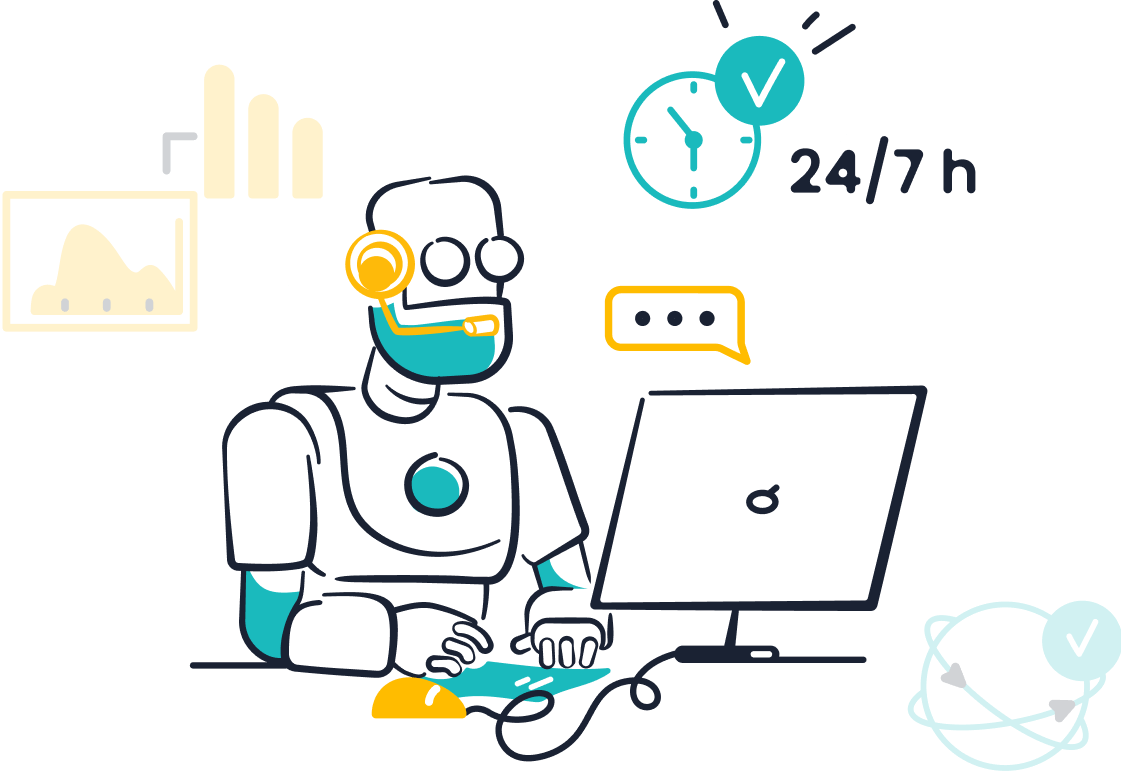
Automated customer service examples in 2025 set new standards for efficiency and customer satisfaction. Businesses now rely on AI chatbots, omnichannel integration, and self-service tools to meet rising expectations. Recent studies show that AI-powered solutions handle up to 95% of interactions, while 80% of customers report positive experiences (Tidio). Companies like Sobot lead this shift, with Sobot AI delivering 24/7 support and driving measurable improvements in customer experience. These trends matter because they boost loyalty, increase revenue, and ensure future-ready operations. Adopting advanced automation helps organizations solve support challenges and elevate customer service for the future.
Automated Customer Service Examples

AI Chatbots
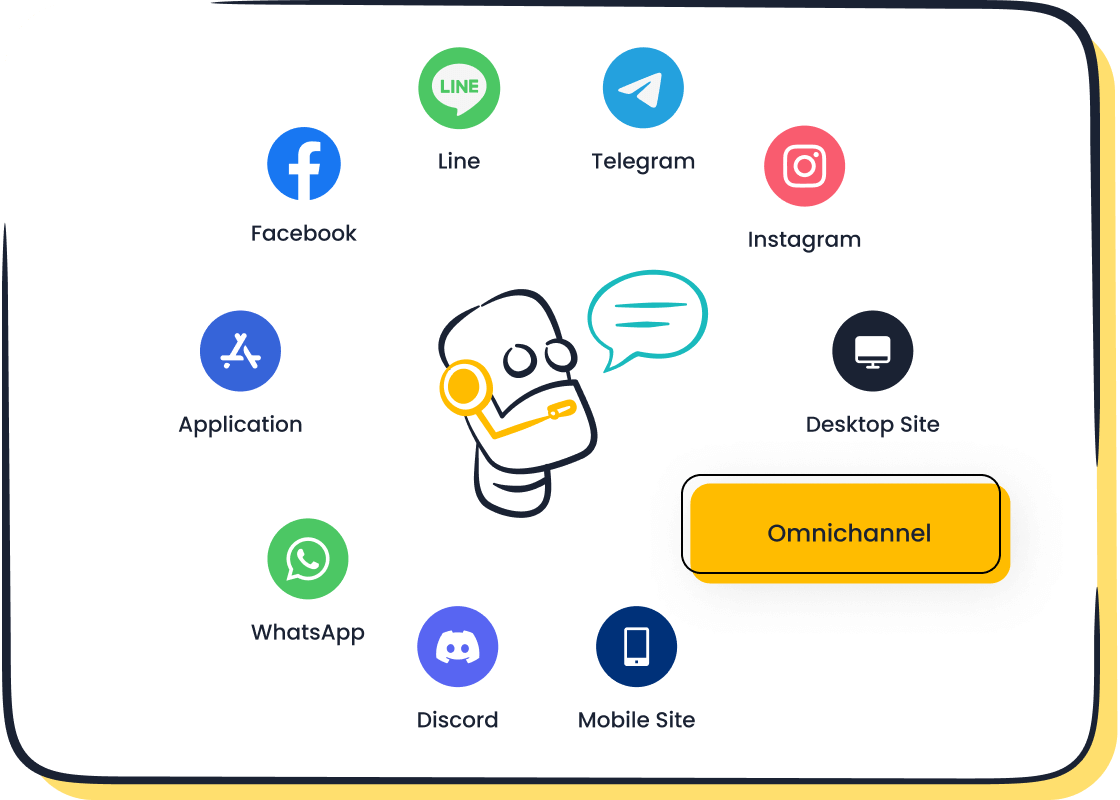
AI chatbots stand at the forefront of automated customer service examples in 2025. Companies use artificial intelligence to automate conversations, answer questions, and guide users through complex processes. Sobot’s AI Chatbot leads the industry with its multilingual, omnichannel capabilities and no-code setup. Businesses benefit from 24/7 support, instant replies, and seamless integration across channels like WhatsApp and SMS. Sobot’s chatbot improves productivity by 70% and reduces agent workload by handling regular queries automatically.
OPPO, a global smart device leader, partnered with Sobot to transform its customer service. The results speak for themselves:
| Metric | Result/Impact |
|---|---|
| OPPO Customer Satisfaction | 93% CSAT achieved with Sobot chatbot |
| Return on Investment (ROI) | 234% increase |
| Agent Workload Reduction | 60% decrease |
| Conversion Rate Improvement | 15% increase |
| Net Promoter Score (NPS) | 35% improvement |
| Resolution Time | Under 1 minute (AI + human support) |
These numbers show how artificial intelligence delivers measurable improvements in customer satisfaction, efficiency, and business growth.
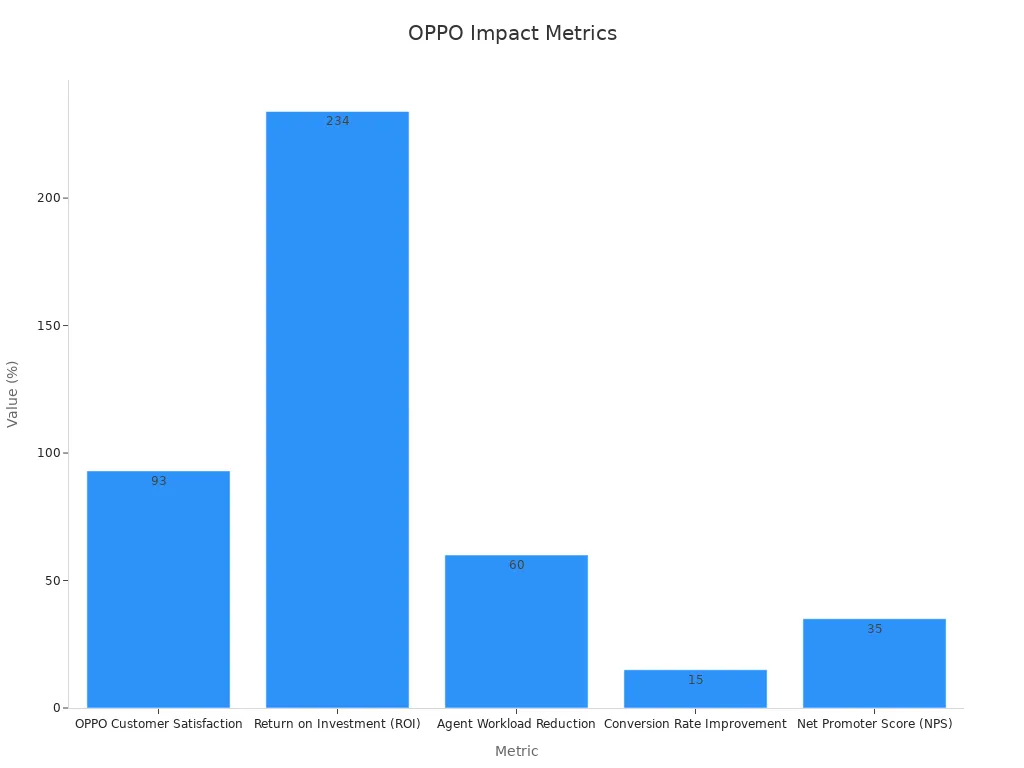
Key performance metrics for AI chatbots include:
- Average resolution time
- Customer satisfaction scores
- First contact resolution rates
- Agent productivity improvements
- Complexity of customer interactions handled
Long-term, companies see scalable solutions, adaptability, and strong ROI, with returns rising from 41% in year one to 124% by year three. Businesses that treat customer service as a value center achieve up to 3.5 times more revenue growth.
Omnichannel Support
Omnichannel support forms the backbone of modern automated customer service examples. Companies connect with customers across chat, email, voice, and social media, creating a unified journey. Sobot’s all-in-one contact center and WhatsApp API enable seamless transitions between channels, ensuring no conversation gets lost.
Surveys show that integrated omnichannel customer experience drives satisfaction and loyalty. Customers value ease of use, personalized service, and consistent support across every touchpoint. Real-time analytics and performance reports help businesses recognize top agents and make informed decisions. Omnichannel customer satisfaction surveys collect feedback from every channel, increasing response rates and supporting immediate improvements.
Note: A strong omnichannel strategy ensures customers receive the same high-quality service, whether they reach out by phone, chat, or social media.
Self-Service Portals
Self-service portals have become essential in automated customer service. Customers want quick answers and the ability to solve problems on their own. Sobot’s AI-powered self-service options provide instant access to FAQs, order tracking, and account management, all without waiting for an agent.
| Metric | Statistic | Source/Context |
|---|---|---|
| Customer preference for self-service portals | 73% prefer websites for issue resolution | Dimension Data survey |
| Customer satisfaction increase (CSAT) | 45% average increase after self-service | Service Target case study |
| Faster issue resolution | 3x faster than traditional channels | ASAR Digital report |
| Customer retention improvement | 67% churn avoidable with first-time resolution | Ameyo study |
| Customers attempting self-service first | 81% try self-service before live support | Harvard Business Review |
| Customer expectation for self-service | 90% expect self-service portals | Microsoft survey |
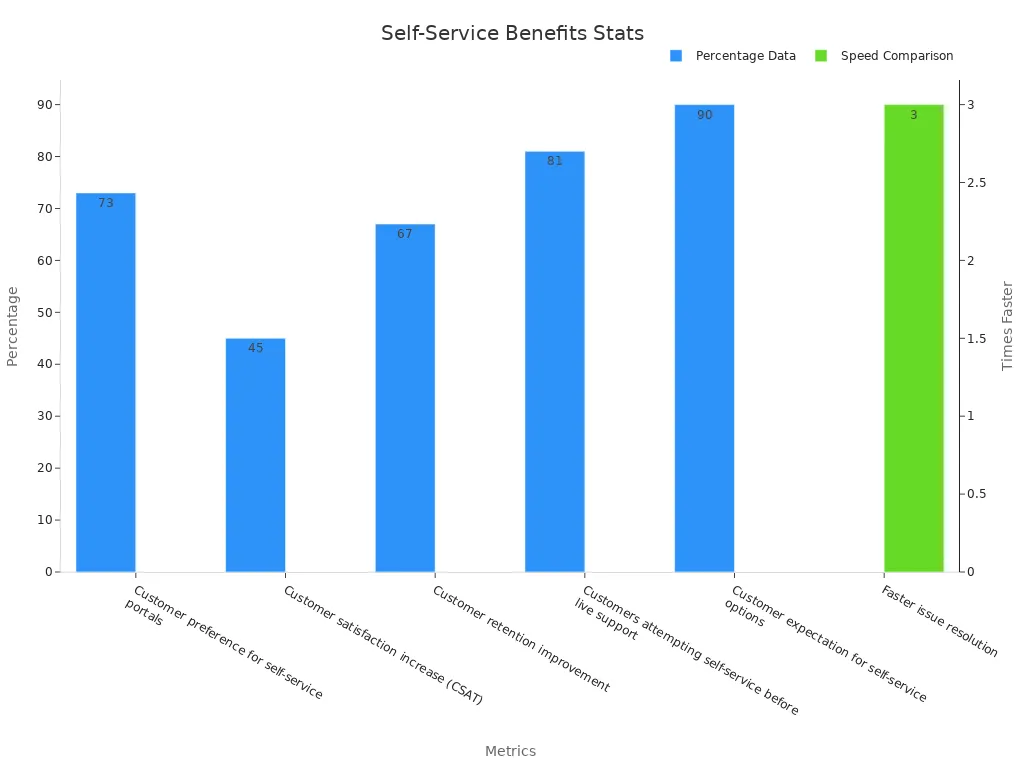
These statistics highlight why self-service options are now a must-have. Customers expect fast, convenient solutions. Businesses that offer robust self-service portals see higher satisfaction, faster resolutions, and improved retention.
Customer Service Trends 2025
Hyper-Personalization
Hyper-personalization stands out as one of the most significant customer service trends shaping the future. Companies now use artificial intelligence and ai-driven automation to analyze customer data and deliver tailored experiences in real time. This approach goes beyond basic segmentation, enabling hyper-personalized interactions that anticipate individual needs and preferences.
Sobot leverages ai to provide personalized service across multiple channels. Its chatbot and live chat solutions use advanced analytics to understand customer intent, language, and behavior. As a result, Sobot’s clients report an 83% chatbot resolution rate and a 94% positive feedback score. Repeat purchases increased by 57% during peak periods, demonstrating the power of hyper-personalization in driving customer engagement and loyalty.
Market analyses confirm the rapid growth of hyper-personalization in customer service:
| Parameter | Detail |
|---|---|
| Market Size (2024) | USD 19.37 Billion |
| Expected CAGR (2024-2033) | 15.83% |
| Revenue Forecast (2033) | USD 72.69 Billion |
| Industry Verticals Covered | BFSI, Retail, E-Commerce, Healthcare & Life Sciences, Media, Education, Others |
| Regional Scope | North America, Europe, Asia-Pacific, Latin America, Middle East & Africa |
| Key Companies Profiled | Adobe Inc., Salesforce Inc., IBM, Google LLC, Oracle, Amazon Web Services, SAP, Microsoft |
| Report Coverage | Market size, revenue forecast, company ranking, competitive landscape, growth factors |
Businesses in retail, finance, healthcare, and education now prioritize hyper-personalization to enhance customer experience and build lasting relationships. The latest trends in customer service show that hyper-personalized interactions lead to higher satisfaction and increased revenue. Sobot’s ai-powered support helps brands deliver these experiences at scale, setting a new standard for personalized customer service.
Proactive Engagement
Proactive engagement has become a defining feature of customer service future trends. Companies no longer wait for customers to reach out with problems. Instead, they use ai-driven automation to anticipate needs and offer solutions before issues arise. This shift improves customer satisfaction and reduces operational costs.
Sobot’s platform enables businesses to send proactive notifications, reminders, and personalized offers through chat, email, and messaging apps. For example, automated reminders reduce appointment no-shows and optimize resource allocation in healthcare and retail. Real-time analytics track key performance indicators such as attendance, satisfaction, and adherence, allowing for targeted interventions.
Companies like Zappos and Kaiser Permanente have demonstrated the value of proactive engagement by anticipating customer needs and providing timely support. These strategies lead to higher retention and improved outcomes.
Organizations using ai-powered support see measurable improvements:
- Reduced operational costs through automation of routine tasks
- Increased customer satisfaction due to timely, relevant outreach
- Enhanced resource utilization and workflow efficiency
- Higher retention rates and repeat business
The latest trends in customer service highlight the importance of proactive engagement in building trust and loyalty. Sobot’s ai solutions empower businesses to stay ahead of customer needs, ensuring a seamless and positive experience.
Emotional Intelligence
Emotional intelligence (EI) represents a crucial element in the evolution of customer service trends. While automation and artificial intelligence drive efficiency, empathy and human touch remain essential for meaningful interactions. Companies now integrate EI into automated solutions to foster stronger emotional connections with customers.
Studies show that brands focusing on emotional intelligence achieve:
| KPI | Improvement Observed |
|---|---|
| Customer Satisfaction Scores | 20% increase |
| Customer Retention Rates | 15% higher retention |
| Conversion Rates | 12% boost |
| Complaint Reduction (Humana) | 73% decrease in complaints |
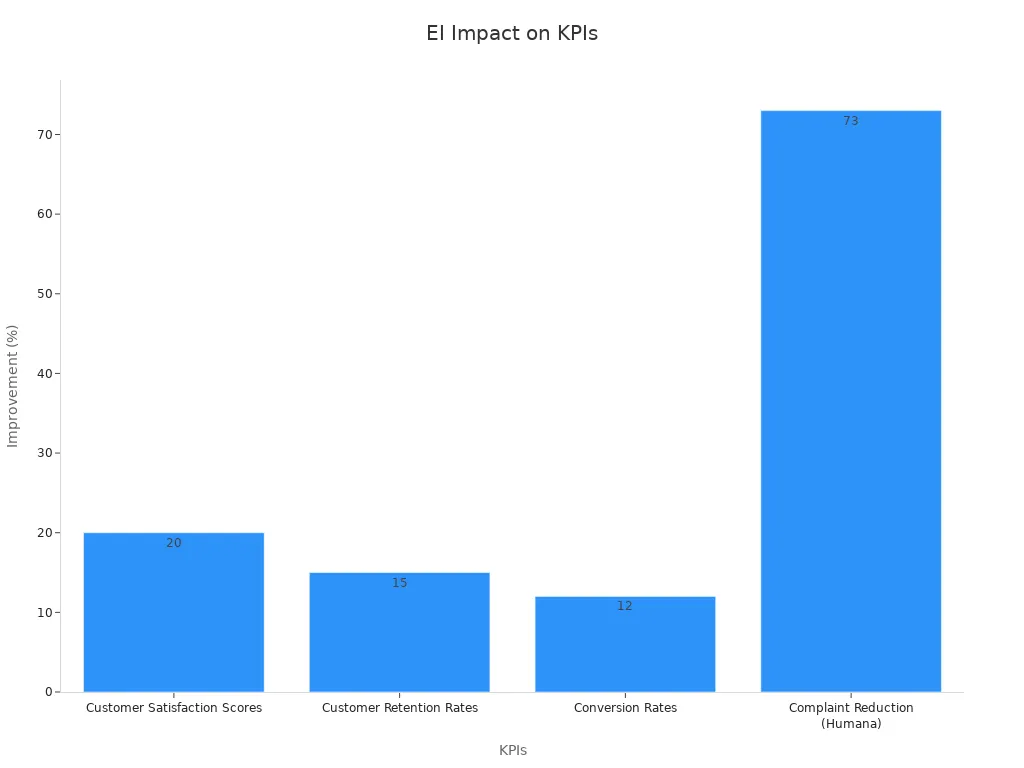
Sobot’s ai-powered support combines automation with empathy. Its chatbots recognize tone and sentiment, adapting responses to match the customer’s mood. This approach reduces stress for both customers and agents, leading to better outcomes and stronger loyalty. The future of customer service will depend on balancing technology with emotional intelligence to deliver exceptional experiences.
Note: 87% of customers consider tone of voice the most important aspect of communication. Companies that prioritize EI in their automated solutions see fewer complaints and higher satisfaction.
Customer service trends in 2025 emphasize the need for hyper-personalization, proactive engagement, and emotional intelligence. Sobot’s ai-driven automation helps businesses deliver personalized, proactive, and empathetic support, setting the benchmark for the future of customer service.
AI in Customer Service
Artificial intelligence continues to transform customer service trends in 2025. Businesses now rely on ai-driven tools to deliver faster, more accurate, and more personalized support. Sobot’s platform stands out by offering advanced ai-driven automation, copilots, and data-driven insights that empower support teams to achieve better results.
Generative AI
Generative AI has become a game-changer in customer service. These ai-driven tools understand customer queries, search multiple knowledge sources, and generate relevant responses for agents to review. Sobot’s ai-powered support uses generative AI to expand brief replies into complete answers, saving time across digital channels. Call note automation captures key information during calls, allowing agents to focus on conversations and improve efficiency.
Key benefits of generative AI include:
- Reducing mean time to resolution by 25-50%
- Lowering support costs through increased ticket deflection
- Enabling 24/7 support without large increases in staffing
- Improving customer satisfaction with quick, multilingual responses
- Boosting agent productivity by reducing response times from ten minutes to two minutes
These improvements help businesses meet modern omnichannel expectations and deliver consistent service quality.
Predictive Analytics
Predictive analytics uses ai-driven automation to anticipate customer needs and optimize service delivery. Sobot’s data-driven insights analyze purchase history, behavior, and sentiment to offer timely suggestions and increase revenue. Algorithms personalize interactions, tailoring recommendations and communication to each customer.
Some ways predictive analytics improves customer service:
- Anticipates needs by analyzing historical data
- Personalizes experiences with targeted recommendations
- Predicts and reduces churn by identifying early warning signs
- Improves first call resolution rates through sentiment analysis
- Optimizes resource allocation by forecasting demand and peak times
A case study showed that predictive analytics helped one organization achieve a 70% first contact resolution rate, boosting loyalty and retention.
Agent Assist Tools
Agent assist tools represent a vital part of ai-driven tools in customer service. Sobot’s copilots provide real-time recommendations and access to knowledge bases, helping agents resolve issues quickly. These tools reduce average handle time and increase first-call resolution rates.
Statistical evidence shows that real-time agent assistance leads to faster call resolutions and shorter durations. By tracking metrics before and after implementation, organizations see measurable reductions in resolution times and improved operational efficiency. Sobot’s agent assist features ensure support teams deliver accurate, timely responses, enhancing both customer and agent experiences.
Omnichannel and Integration Trends
Unified Customer Journeys
Unified customer journeys have become a cornerstone of modern omnichannel strategies. Businesses now connect every touchpoint—chat, email, voice, and social media—into a seamless experience. Sobot’s all-in-one contact center and WhatsApp API integration allow companies to manage conversations from multiple channels in one place. This approach reduces operational costs, improves satisfaction, and streamlines internal collaboration.
- Unified experiences lower redundant tasks and speed up responses.
- Teams work together more efficiently, using integrated tools like CRM and chatbots.
- Customers expect consistent service, with 75% demanding it across all channels.
- Brands that deliver unified journeys see higher loyalty and retention.
AI and orchestration tools help personalize interactions in real time, building trust and driving repeat business. Companies like Spotify and Zappos show how unified journeys reduce frustration and improve key metrics such as satisfaction and resolution times.
Voice and Conversational AI
Voice and conversational AI are shaping new customer service trends. Sobot’s omnichannel platform supports voice calls, live chat, and messaging, using AI to analyze and optimize every interaction. Voice analytics platforms process call recordings and transcriptions, using speech-to-text and sentiment analysis to extract insights. These tools monitor customer satisfaction scores, Net Promoter Scores, and resolution times.
Conversational AI tools also track trends in customer engagement, helping businesses identify at-risk customers and improve agent performance. Real-time scoring and targeted coaching ensure that support teams deliver timely, personalized service across all channels.
Data Privacy and Security
Data privacy and security remain top priorities in omnichannel customer service trends. Sobot demonstrates a strong commitment to compliance, using industry-leading standards and certifications. Integrated platforms undergo regular audits, such as SOC 1 & SOC 2, ISO/IEC 27001:2013, and ISO/IEC 27701:2019, to ensure robust security and privacy management.
| Report/Certification | Description | Evidence of Improvement |
|---|---|---|
| SOC 1 & SOC 2 | Third-party audits on security controls | Ongoing compliance and effective security controls |
| ISO/IEC 27001:2013 | Security management standard | Rigorous security program implementation |
| ISO/IEC 27701:2019 | Privacy management for personal data | Continuous improvement in privacy management |
| ISO 27017 & ISO 27018 | Cloud security and personal data protection | Enhanced cloud security and privacy controls |
| CSA CAIQ | Cloud security controls questionnaire | Transparency and third-party validation |
Sobot’s approach includes risk assessments, vendor compliance checks, and continuous monitoring. These steps ensure that customer data stays protected, supporting trust and regulatory compliance in every omnichannel interaction.
Personalization in Automated Support

Customer Insights
Customer insights drive the next wave of hyper-personalization in automated support. Companies now use advanced analytics to gather data on customer behavior, preferences, and engagement. Platforms like Dynamics 365 Customer Insights track metrics such as customer lifetime value, churn risk, and purchasing propensity. These insights allow businesses to forecast revenue, identify at-risk users, and tailor every interaction. Studies show that using these metrics can reduce customer journey build time by 75% and outreach time by 25%. Sobot’s Chatbot leverages similar data-driven approaches, consolidating information from multiple sources to deliver hyper-personalized interactions. This strategy helps organizations increase retention and build customer loyalty by responding to individual needs.
Real-Time Responses
Real-time responses are essential for delivering personalized customer service. Automation enables instant replies, reducing wait times and improving satisfaction. Analysis of over 14,000 merchants using automation reveals significant improvements:
| Metric | Improvement with Automation |
|---|---|
| Repeat Purchases | +36% |
| First Response Time | -37% |
| Resolution Time | -52% |
| Ticket-to-Order Ratio | -27% |
| Customer Satisfaction (CSAT) | +1% |
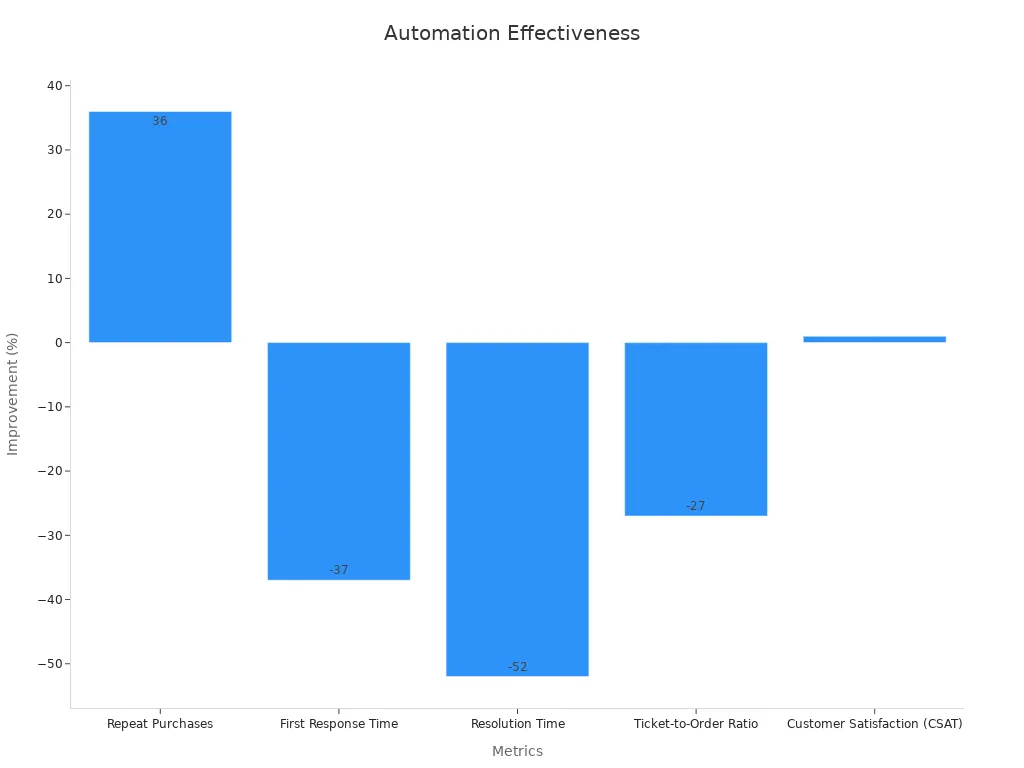
Sobot’s Chatbot uses AI to provide real-time, context-aware answers across channels. This approach supports self-service and ensures customers receive timely help, which increases retention and customer loyalty.
Customizable Solutions
Customizable solutions allow businesses to adapt automated support to their unique needs. Sobot’s Chatbot enables organizations to segment customers, personalize messages, and automate timely responses. Key performance measures include:
- Segmenting users by behavior or demographics for targeted communication.
- Personalizing messages based on purchase history and interests.
- Automating triggers for relevant responses, such as thank you emails or discounts.
- Delivering personalized service at scale to boost satisfaction and retention.
- Monitoring and optimizing strategies using engagement metrics like click-through rate, conversion rate, and time spent on page.
These capabilities help companies refine their automation, improve engagement, and foster customer loyalty. Sobot’s flexible platform supports ongoing optimization, ensuring every customer receives a tailored experience.
Best Practices for Adopting Automation
Implementation Steps
Successful automation in customer service starts with a clear plan. Companies should first identify which processes benefit most from automation. For example, Sobot’s AI-powered solutions help businesses automate routine queries and streamline workflows. Next, integration with existing systems is essential. Training teams on new tools ensures everyone understands how to use automation effectively. Strong management support and collaboration, as seen in the Sharp Electronics Indonesia case, lead to smoother rollouts and higher adoption rates. Companies also benefit from ongoing optimization, using feedback and analytics to refine automated processes.
Tip: Involve both IT and customer service teams early in the project to ensure seamless integration and user acceptance.
Some real-world examples of effective automation deployment include:
- Insurance adjusters using AI and AR to process claims remotely, saving time and increasing satisfaction.
- Healthcare providers managing chronic care through virtual engagement, improving outcomes for patients.
- Repair networks standardizing workflows with digital automation, reducing errors and speeding up projects.
Balancing AI and Human Agents
Finding the right balance between AI and human agents is key to excellent customer service. AI handles repetitive, low-complexity tasks like order tracking or password resets. Human agents step in for complex or emotional issues that require empathy and judgment. Companies use sentiment analysis to decide when to transfer a conversation from AI to a person. This approach improves satisfaction and reduces churn.
- AI agents excel at predictable, low-risk tasks.
- Human agents resolve complex or sensitive issues.
- Metrics such as resolution rate and sentiment trajectory help optimize this balance.
Organizations like Mid-Atlantic Federal Credit Union have reduced wait times by automating routine inquiries, allowing human agents to focus on more challenging cases.
Measuring Success
Measuring the impact of automation helps companies refine their strategies. Key metrics include:
| Metric | What It Measures |
|---|---|
| Customer Satisfaction (CSAT) | Sentiment after interactions |
| Net Promoter Score (NPS) | Loyalty and likelihood to recommend |
| Churn Rate | Percentage of customers leaving |
| First Contact Resolution | Efficiency in solving issues |
| Self-Service Rate | Use of automated solutions |
| Customer Lifetime Value (CLV) | Long-term customer value |
Sobot’s analytics dashboard tracks these metrics in real time, helping businesses optimize performance and improve customer service. Companies that monitor these indicators see higher retention, better engagement, and stronger results as automation becomes a core part of their customer service trends.
Automated customer service in 2025 delivers measurable business growth and customer satisfaction. Companies see benefits such as proactive support, omnichannel journeys, and personalization at scale. Sobot’s AI-powered solutions help brands achieve faster resolution times, a 234% ROI, and a 35% improvement in Net Promoter Score.
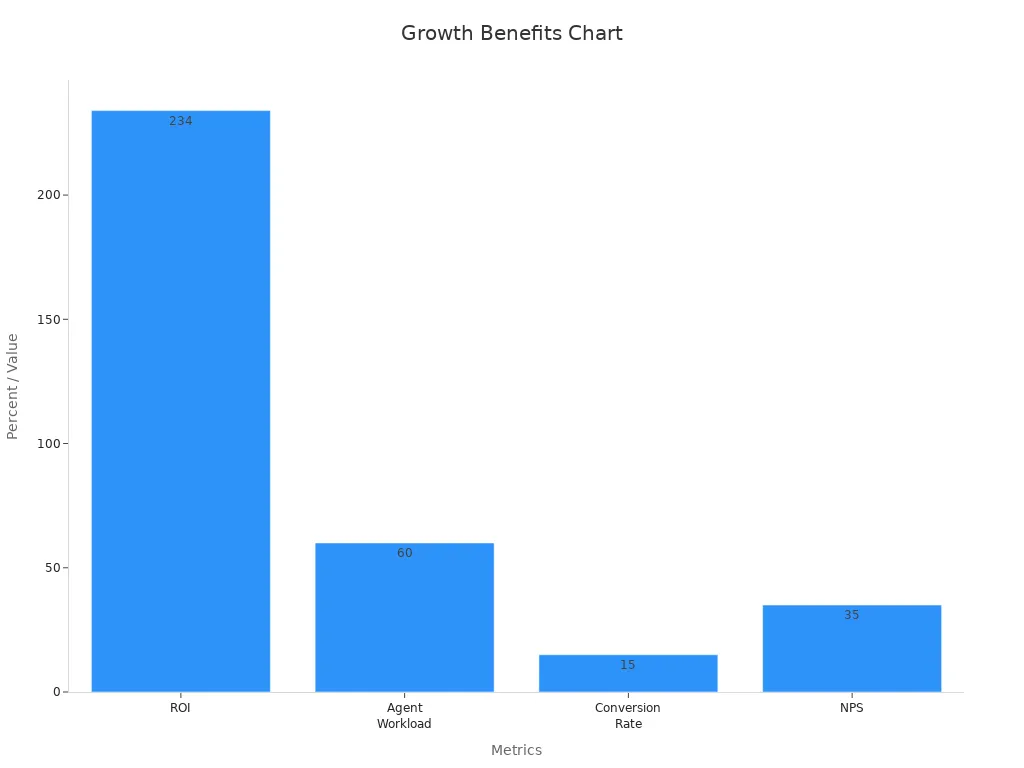
To prepare for the future, organizations should explore platforms like Sobot, invest in employee training, and adopt scalable automation. Staying informed about new trends ensures every customer experience remains exceptional.
FAQ
What are the main benefits of automated customer service in 2025?
Automated customer service improves efficiency, reduces costs, and boosts customer satisfaction. Companies like Sobot report a 70% productivity increase and 50% cost savings. AI-driven automation delivers 24/7 support, faster resolutions, and higher retention rates, making it essential for the future of customer experience.
How does omnichannel customer experience impact customer loyalty?
Omnichannel customer experience connects every touchpoint, such as chat, email, and voice. This approach ensures consistent, personalized service. Studies show that brands with strong omnichannel strategies achieve 89% higher customer retention and loyalty. Sobot’s platform unifies channels for seamless support and better engagement.
Why is hyper-personalization important in customer service trends?
Hyper-personalization uses AI and data-driven insights to tailor every interaction. Businesses see a 57% increase in repeat purchases and a 94% positive feedback rate. Sobot’s AI-powered support enables hyper-personalized interactions, helping brands deliver the latest trends in customer service and drive customer loyalty.
What role do self-service options play in customer engagement?
Self-service options empower customers to solve issues quickly. Over 81% of users try self-service before contacting support. Sobot’s AI chatbot provides instant answers, improving customer satisfaction and reducing wait times. Companies offering robust self-service see higher engagement and improved retention.
How do AI-driven tools enhance personalized customer service?
AI-driven tools analyze behavior and preferences to deliver personalized service. Sobot’s solutions use artificial intelligence to provide real-time responses and proactive support. This approach increases customer satisfaction, boosts retention, and ensures every customer receives a tailored experience across all channels.
See Also
The Best Customer Support Software Ranked For 2024
Leading Voice Of Customer Platforms To Watch In 2024
Revealing The Best Cloud-Based Contact Centers For 2025
